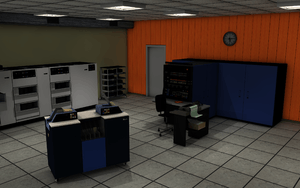IBM System/370 Model 145
The IBM System/370 Model 145 was announced September 23, 1970,[1] three months after the 155 and 165[2] models. It was the fourth member of the IBM System/370 line of computers,[3] and was the first IBM computer to use semiconductor memory for its main memory instead of magnetic core memory.[4] It was described as being five times faster than the IBM System/360 Model 40. First shipments were scheduled for late summer of 1971.[1]
 | |
 IBM System/370 Model 145 | |
| Manufacturer | International Business Machines Corporation (IBM) |
|---|---|
| Product family | System/370 |
| Generation | Third |
| Release date | September 23, 1970 |
| Introductory price | $705,775 to $1,783,000 |
| Memory | semiconductor (first IBM use for main memory), 112–512 KB |
| Storage | IBM 3330, IBM 2319 |
| Backward compatibility | IBM System/360, IBM 1400 series, IBM 7010 |
| Website | Official website IBM Archives |


New capabilities
The System/370's basic architecture was described as having been an extension, but not a redesign, from that of IBM's 1964-introduced System/360.[2]
The 370 introduced some new instructions, such as
- MOVE CHARACTER LONG (MVCL) and
- COMPARE CHARACTER LONG (CLCL),
thereby permitting operations on up to 224-1 bytes (16 MB), vs. the 256-byte limits on the 360's MVC and CLC,[5][6] but lacked a DAT (Dynamic Address Translation) box.
Virtual memory
Some said about the early members of the IBM System/370 family, looking back, that they were not "the real 370 line" because "neither offered virtual storage capability, which was to be a hallmark of the 370 line."[7]
Unlike the earlier Model 155 and 165 systems, for which an upgrade to virtual memory required the purchase of an expensive upgrade to add a DAT box,[7] the 145's customers had two advantages:
- 370/145 customers did not have to wait as long for this lack of virtual memory to be remedied[NB 1]
- there was no need to buy extra hardware: An upgrade to the 145's microcode through a new microcode floppy disk[8] enabled virtual memory capability.
VM/CMS
Upon gaining virtual memory capability via a microcode update, the 145 could now support the VMF (Virtual Machine Facility) and VM/CMS, a time-sharing system.
Notes
- June 1971 vs. Aug. 1972
References
- "System/370 Model 145". IBM Archives. IBM.
- "System/370 Model 165". IBM Archives. IBM.
- A third 370, the 370/195, had separately been announced the same day as the 155 & 165. The new 195 came about 14 months after the announcement of the 360/195. Both 195 machines were withdrawn Feb. 9, 1977. See https://www-03.ibm.com/ibm/history/exhibits/mainframe/mainframe_PP2195.html and https://www-03.ibm.com/ibm/history/exhibits/mainframe/mainframe_PP3195.html
- William D. Smith (September 24, 1970). "A new computer unveiled by I.B.M". The New York Times.
- http://faculty.cs.niu.edu/~byrnes/csci360/notes/360ex.htm
- http://research.microsoft.com/en-us/um/people/gbell/tcmwebpage/timeline/chap51_ibm370_cs2.pdf
- "What Course for the 3081?". Computerworld. November 24, 1980. p. 34.
- IBM Maintenance Library 3145 Processing Unit Theory - Maintenance. IBM. pp. CPU 117–129. SY24-3581-2